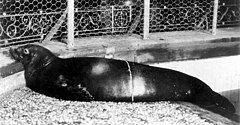| Caribbean monk seal | |
|---|---|

| |
| Specimen in the New York Aquarium, c. 1910 | |
| Scientific classification | |
| Domain: | Eukaryota |
| Kingdom: | Animalia |
| Phylum: | Chordata |
| Class: | Mammalia |
| Order: | Carnivora |
| Clade: | Pinnipedia |
| Family: | Phocidae |
| Genus: | Neomonachus |
| Species: | †N. tropicalis
|
| Binomial name | |
| †Neomonachus tropicalis (Gray, 1850)
| |
| Synonyms | |
|
Monachus tropicalis (Gray, 1850)[1] | |
The Caribbean monk seal (Neomonachus tropicalis), also known as the West Indian seal or sea wolf, is an extinct species of seal native to the Caribbean. The main natural predators of Caribbean monk seals were large sharks, such as great whites and tiger sharks, and possibly transient orcas (though killer whales are not often sighted in the Caribbean); however, humans would become their most lethal enemy.[3] Overhunting of the monk seals for oil and meat, as well as overfishing of their natural prey, are the likely reasons for the seals' extinction.[3]
The last confirmed sighting of a Caribbean monk seal was in 1952, at Serranilla Bank, in the waters west of Jamaica and off the eastern coast of Nicaragua.[4] In 2008, the species was officially declared extinct by the United States, after an exhaustive five-year search. This analysis was conducted by the National Marine Fisheries Service of the National Oceanic and Atmospheric Administration (NOAA).[5] The Caribbean monk seal is closely related to the critically endangered Hawaiian monk seal, a species which is restricted to the central Pacific Ocean surrounding the Hawaiian Islands, and the Mediterranean monk seal, another endangered species, predominantly found in the waters off of Greece.[6][7]
- ^ a b c Lowry, L. (2015). "Neomonachus tropicalis". IUCN Red List of Threatened Species. 2015: e.T13655A45228171. doi:10.2305/IUCN.UK.2015-2.RLTS.T13655A45228171.en. Retrieved 18 November 2021.
- ^ "NatureServe Explorer 2.0". explorer.natureserve.org. Retrieved 29 March 2022.
- ^ a b Cite error: The named reference
Kingwas invoked but never defined (see the help page). - ^ Cite error: The named reference
Ricewas invoked but never defined (see the help page). - ^ Kyle Baker; Jason Baker; Larry Hanse; Gordon T. Waring (March 2008). "Endangered Species Act 5-Year Review Caribbean Monk Seal (Monachus tropicalis)". National Oceanic and Atmospheric Administration National Marine Fisheries Service.
- ^ Fisheries, NOAA (March 8, 2018). "What's the Latest on Hawaiian Monk Seals? | NOAA Fisheries". NOAA.
- ^ "MOm Website". Archived from the original on 2012-03-16. Retrieved 2011-12-11.

